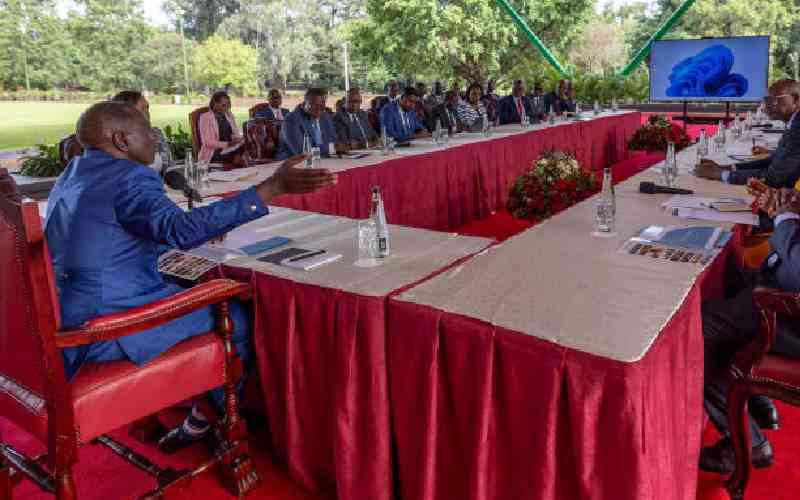
Almost one in every two inmates across the country’s prisons is yet to be sentenced, as low resource allocation and inadequate manpower drag the wheels of justice for millions of Kenyans.
The latest data from the State of the Judiciary Report indicates that the number of pending cases continues to rise even as the gap between the required judicial officers and those employed widens.
The number of principal magistrates, for instance, stands at 98, less than half of the 240 required by the Judiciary.
Despite the resource gaps, President Uhuru Kenyatta recently rebuffed protests by the Judiciary that it needs more money to execute its mandate of serving all who seek justice.
Further, the Treasury revealed new Budget cuts for the 2020-21 financial year, with allocations to the Judiciary falling from Sh19 billion in the current fiscal year to Sh13.6 billion, a three-year low.
Increasing workload
Chief Justice David Maraga last year sought more resources, stressing that the Judiciary was working with limited resources despite the pressure to deliver more convictions in high-profile cases.
“As the Judiciary’s budget is dwindling, the workload is rising tremendously,” he said during a press conference in November last year.
“As you all know, many Kenyans come to court to have their disputes resolved and this has resulted in an average of 400,000 cases that are filed every year. With the current manpower, the Judiciary is only able to clear an average of 300,000 cases every year.”
The State of the Judiciary Report notes that as of June 2018, the case backlog – cases that remain unresolved one year after filing – stood at 372,928.
A year later, this number rose nine per cent to 381,056.
But there has been measured success in lowering the rate of cases hitting the five-year mark. According to the Judiciary, this is a result of new measures such as mobile courts and mediation programmes.
“At the beginning of 2017, there were 170,186 court cases older than five years in the Judiciary,” says the report.
“At the end of the reporting period (June 2019), 86,716 cases older than five years had been cleared in all courts, translating into an achievement level of 110 per cent.”
Stay informed. Subscribe to our newsletter
At the same time, 39,781 cases transitioned from being in the justice system for less than five years to the five-year mark at the end of June last year.
The figures point to increased pressures on the country’s justice system to accommodate the twin challenge of handling new cases and clearing the piling backlog, which the report terms an "undesirable phenomena".
This is reflected in the overcrowding experienced in the country’s 129 institutions under the Kenya Prisons Service, currently housing almost twice the intended population.
“The daily average prisoners’ population is 55,000, comprising 30,000 convicted and 25,000 unconvicted prisoners plus 300 children aged below four accompanying their mothers in prison,” explained the Judiciary in its report.
“The official holding capacity is 30,000 prisoners, meaning that the prison facilities are overcrowded by about 83 per cent.”
This is despite 11,000 inmates having their sentences revised to non-custodial sentences and six new women prisons being gazetted to decongest the existing facilities.
The case backlog coincides with the human resource gap experienced in the Judiciary, particularly in the magistrates’ courts that carry the bulk of pending cases.
Of the 437,387 cases pending in these courts, more than half have been in the system for more than a year. Of these, 25,367 are older than five years.
With 121 stations across 290 sub-counties, the magistrates’ court is the highest legal station accessible to Kenyans in all corners of the country. Yet, the Judiciary has 208 senior resident magistrates currently in service across the country, just over half of the 400 required.
Labour gaps
But despite its resource constraints and labour gaps, the revenue collected from fines and fees in courts stood at Sh2.6 billion as at the end of June 2019, a 30 per cent increase from Sh2 billion collected in 2017, the report notes.
The Judiciary has also seen an increase in the revenue generated from its services.
However, the number of complaints made to the Judiciary regarding slow service, missing files or poor service increased by 175, 142 and 148, respectively, between 2018 and 2019.
The Judiciary says this was the result of a proportionate increase in the number of Kenyans seeking to file cases in court vis-à-vis the number of judicial officers available.
But the justice system is not the only arm of government facing budget constraints. At the launch of the Judiciary report, President Kenyatta asked the Executive to keep public interest at the forefront of its mandate and work within the resources provided.
He, however, castigated the Judiciary for complaining about a lack of resources while approving injunctions to stop government projects, which he claimed are meant to raise public revenue.
[email protected]
 The Standard Group Plc is a
multi-media organization with investments in media platforms spanning newspaper
print operations, television, radio broadcasting, digital and online services. The
Standard Group is recognized as a leading multi-media house in Kenya with a key
influence in matters of national and international interest.
The Standard Group Plc is a
multi-media organization with investments in media platforms spanning newspaper
print operations, television, radio broadcasting, digital and online services. The
Standard Group is recognized as a leading multi-media house in Kenya with a key
influence in matters of national and international interest.
 The Standard Group Plc is a
multi-media organization with investments in media platforms spanning newspaper
print operations, television, radio broadcasting, digital and online services. The
Standard Group is recognized as a leading multi-media house in Kenya with a key
influence in matters of national and international interest.
The Standard Group Plc is a
multi-media organization with investments in media platforms spanning newspaper
print operations, television, radio broadcasting, digital and online services. The
Standard Group is recognized as a leading multi-media house in Kenya with a key
influence in matters of national and international interest.










